
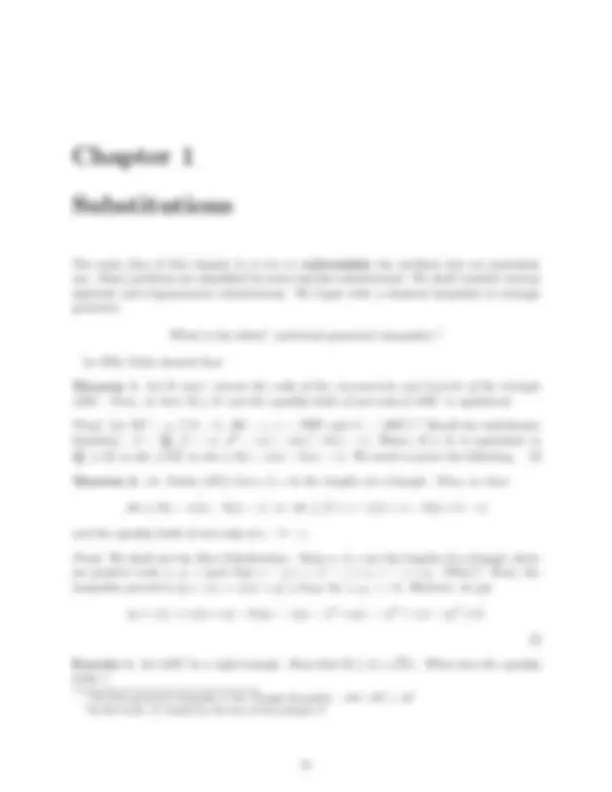
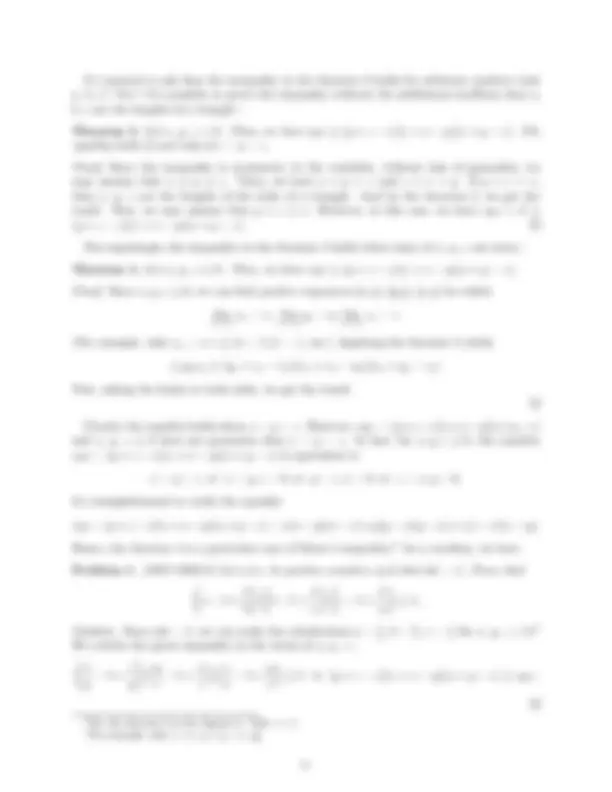
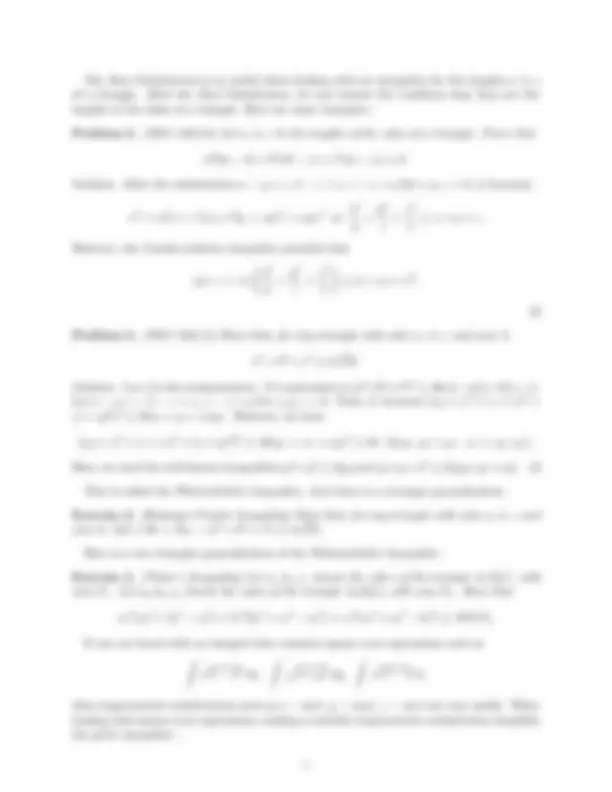
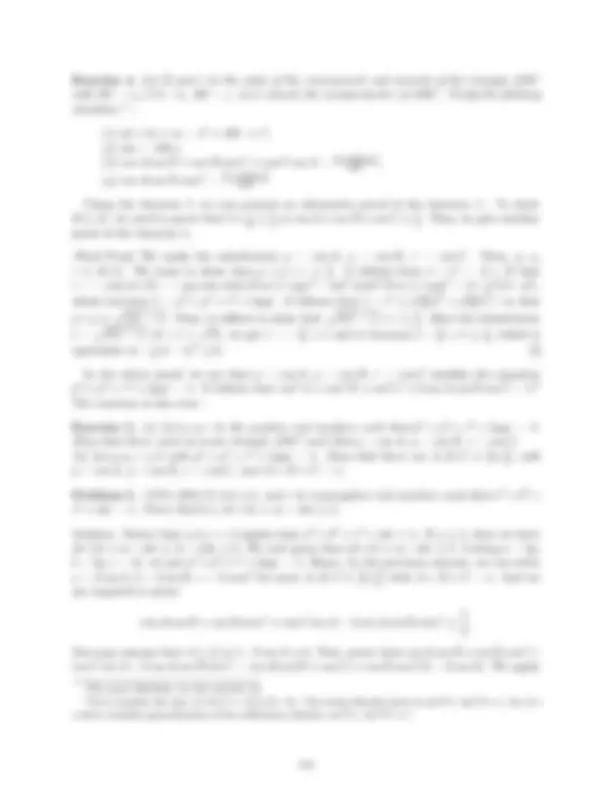
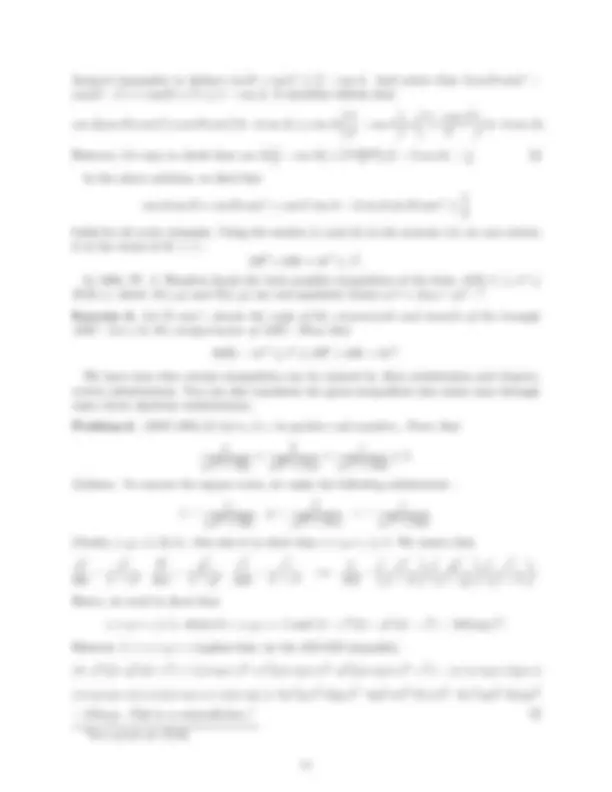
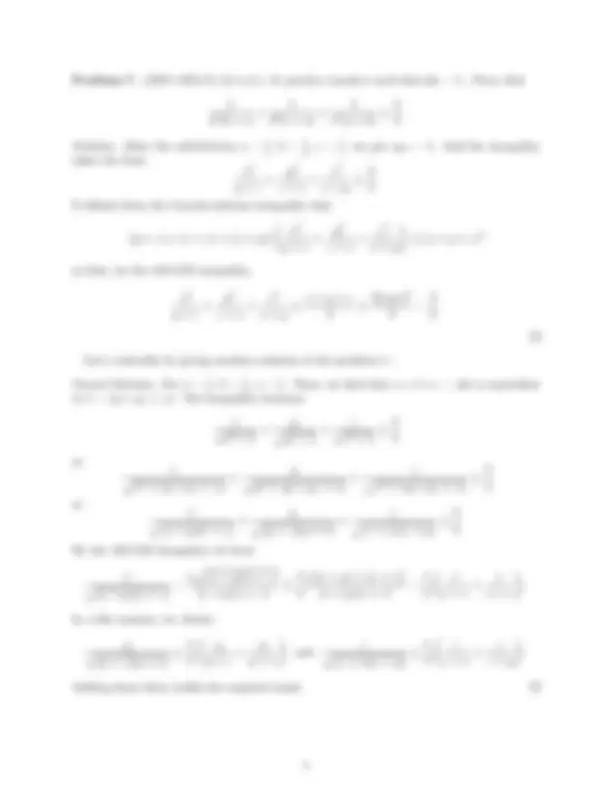
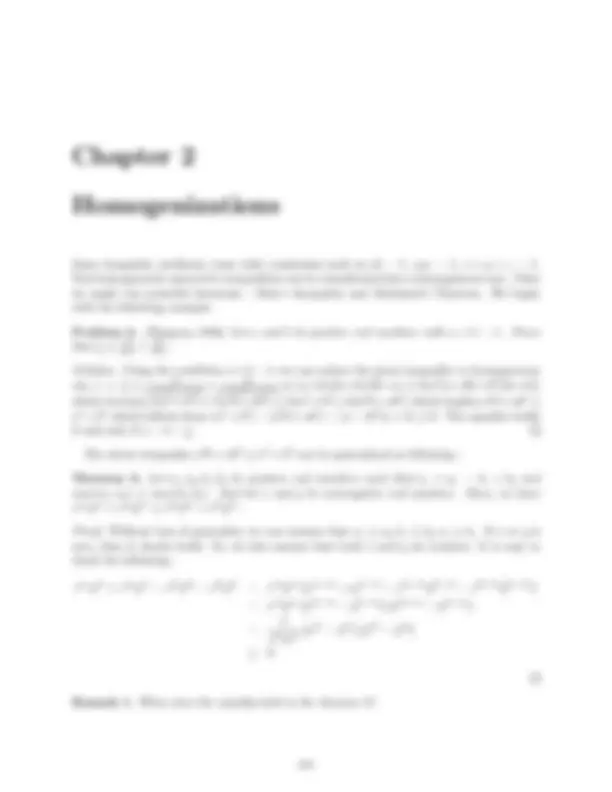
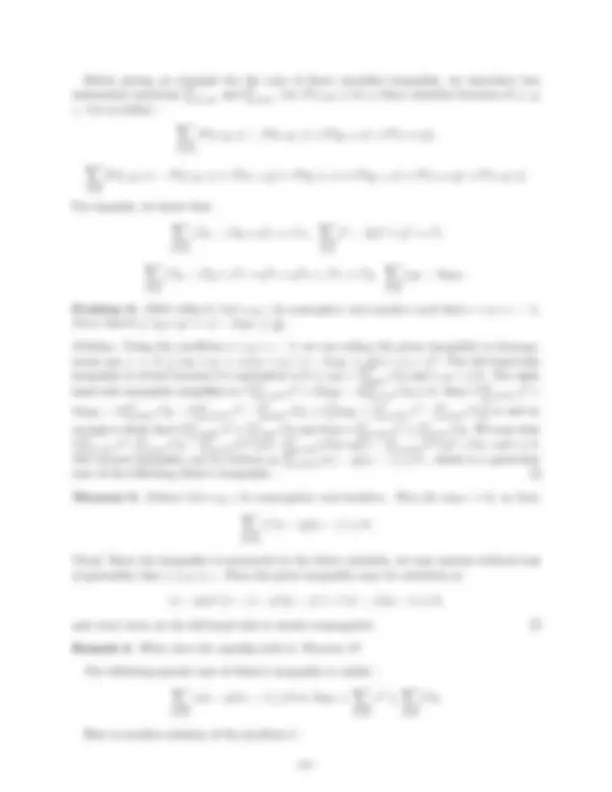
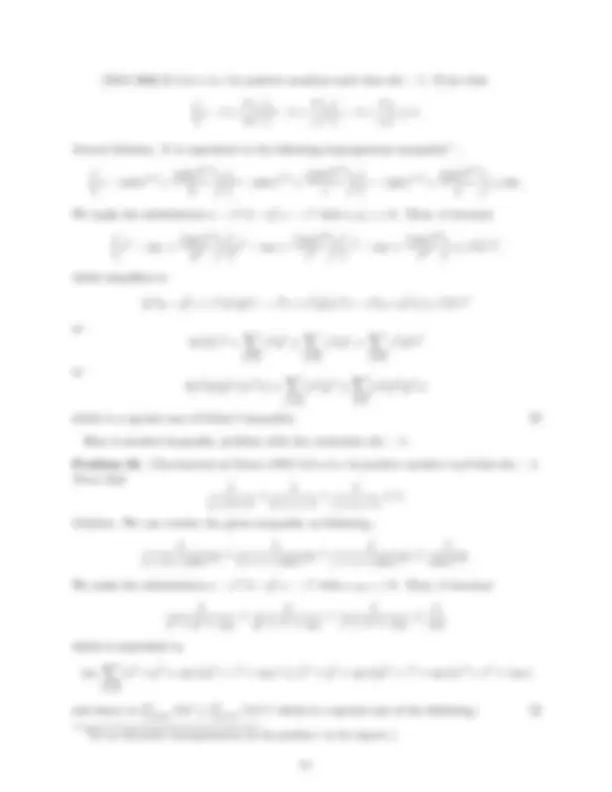
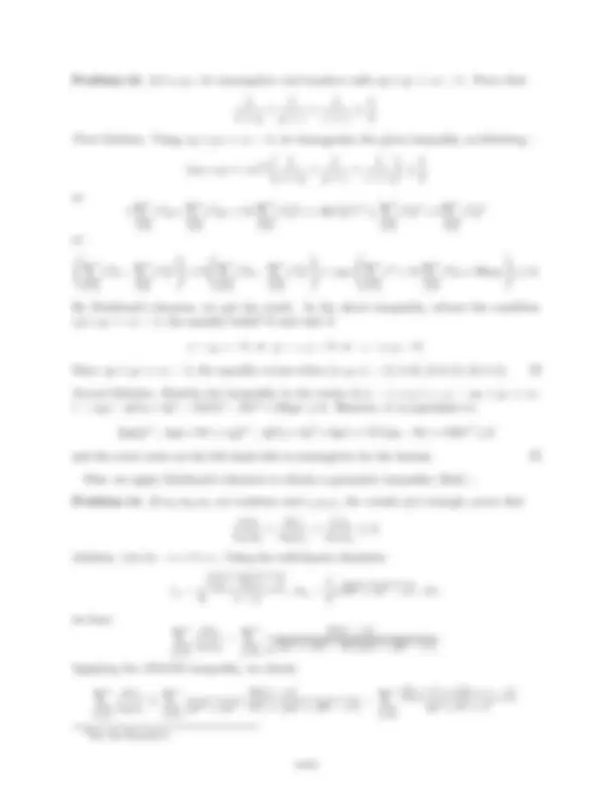
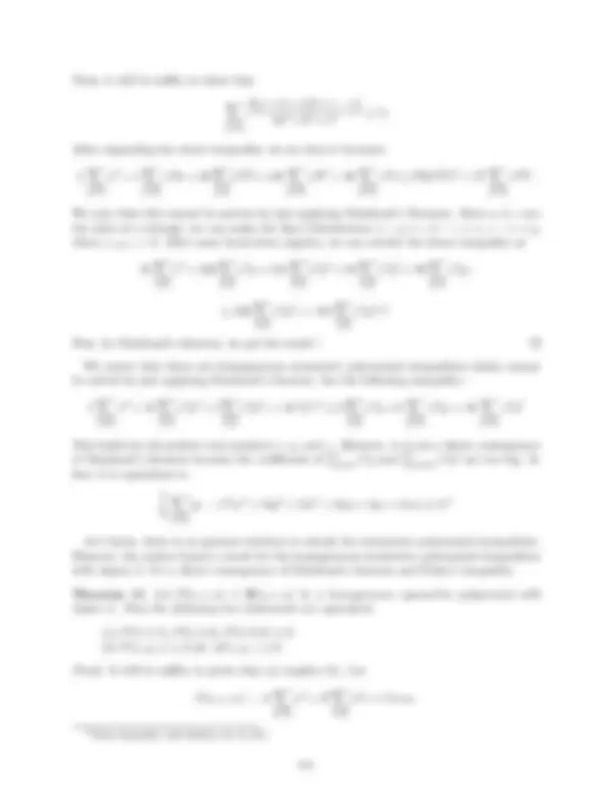
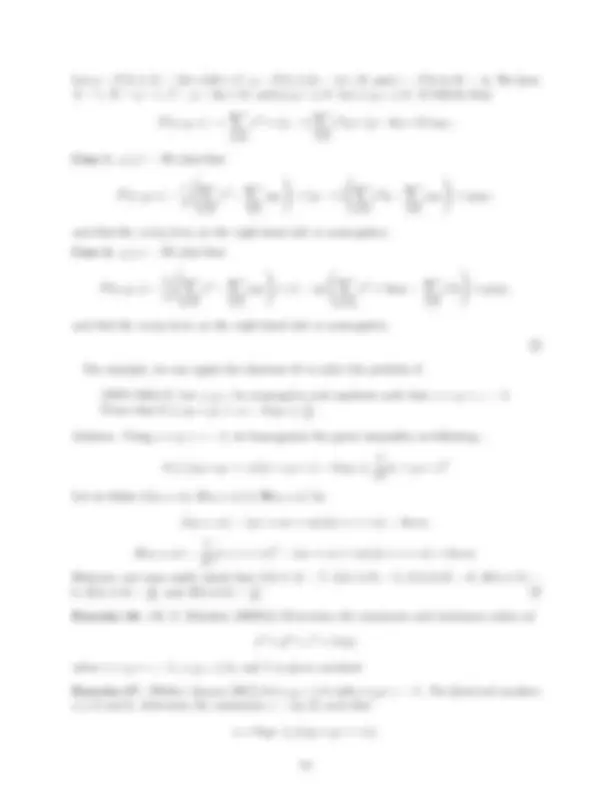
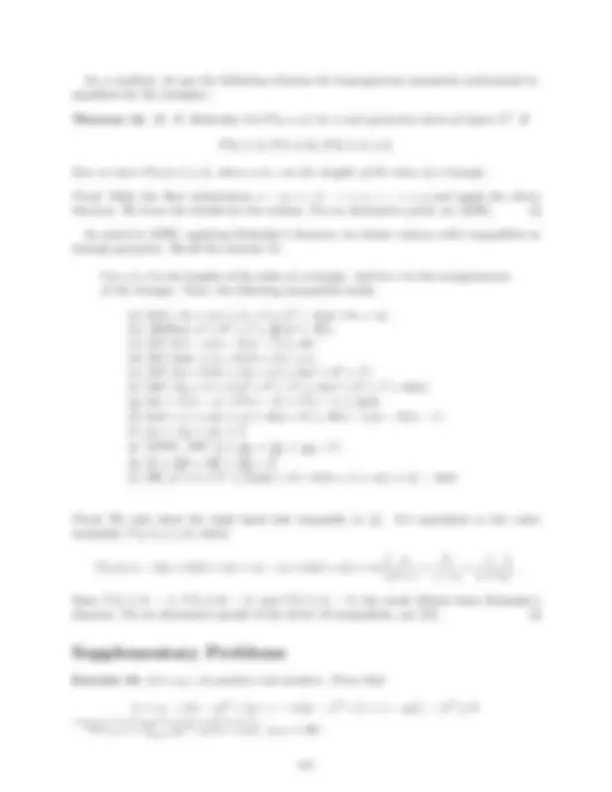
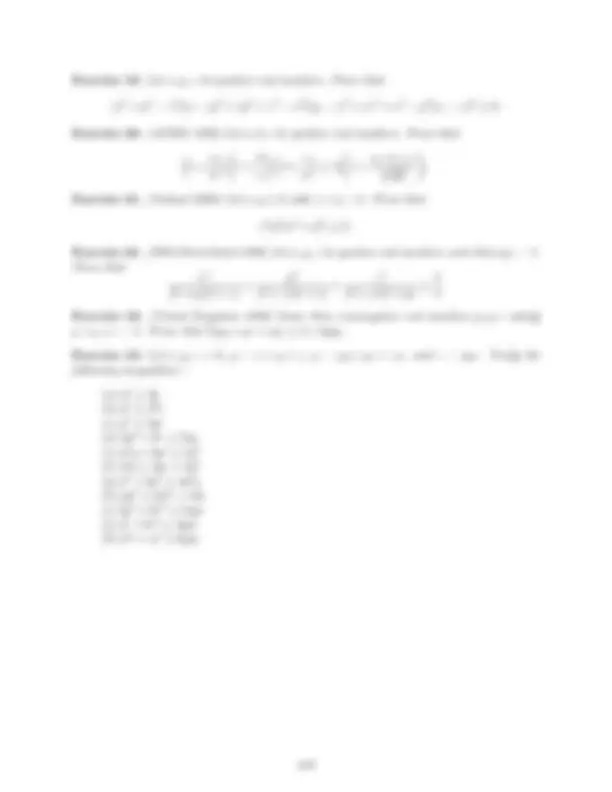
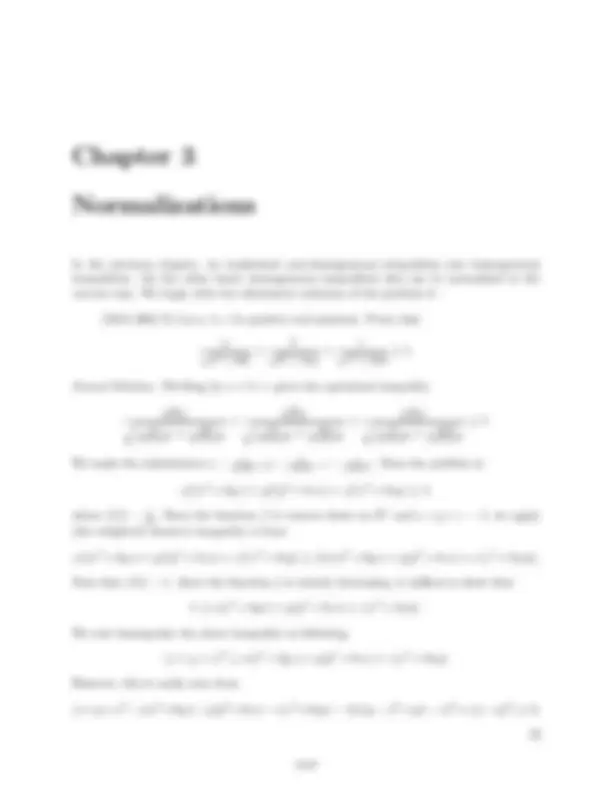
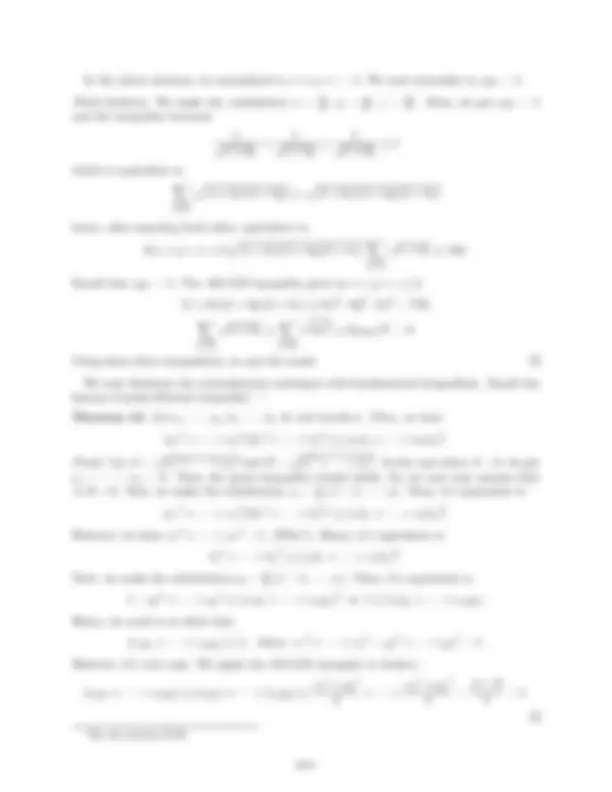
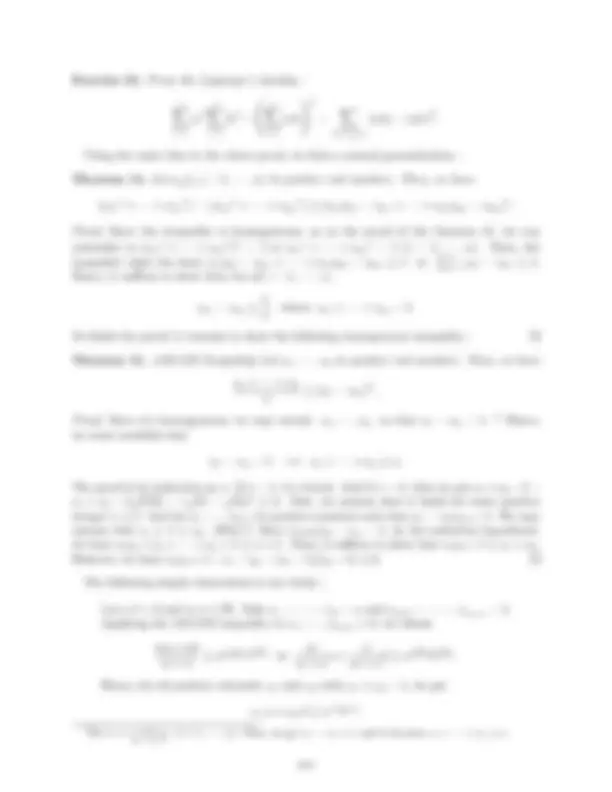
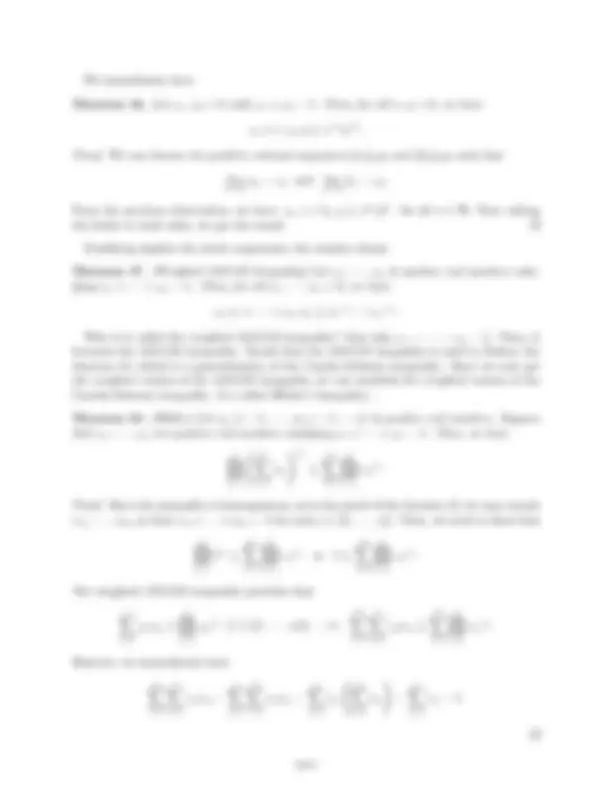
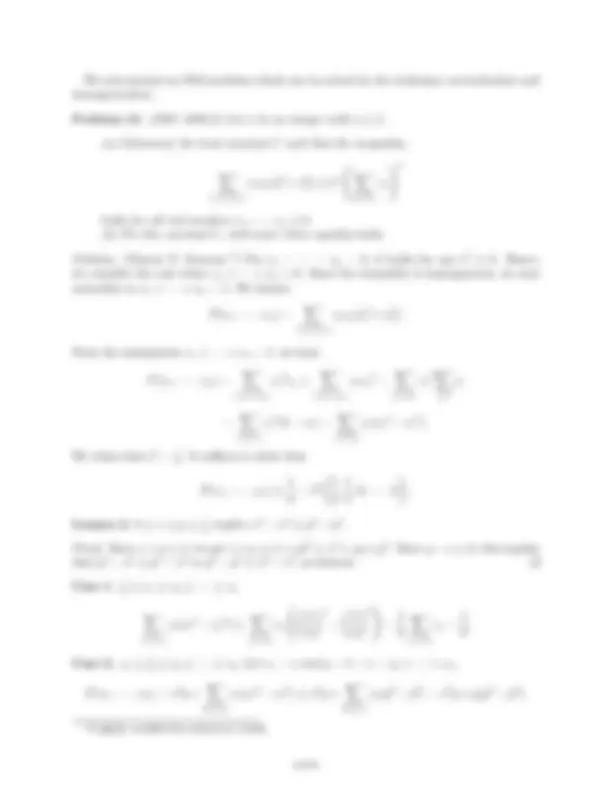
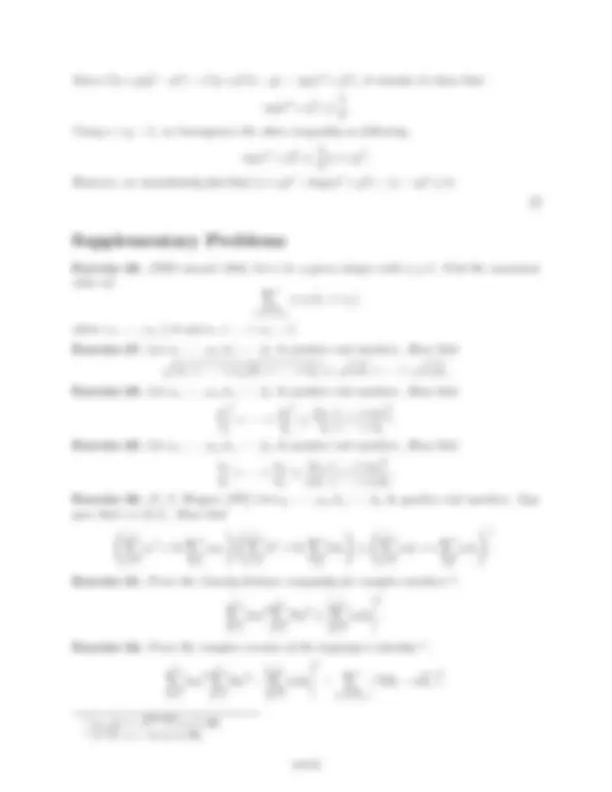
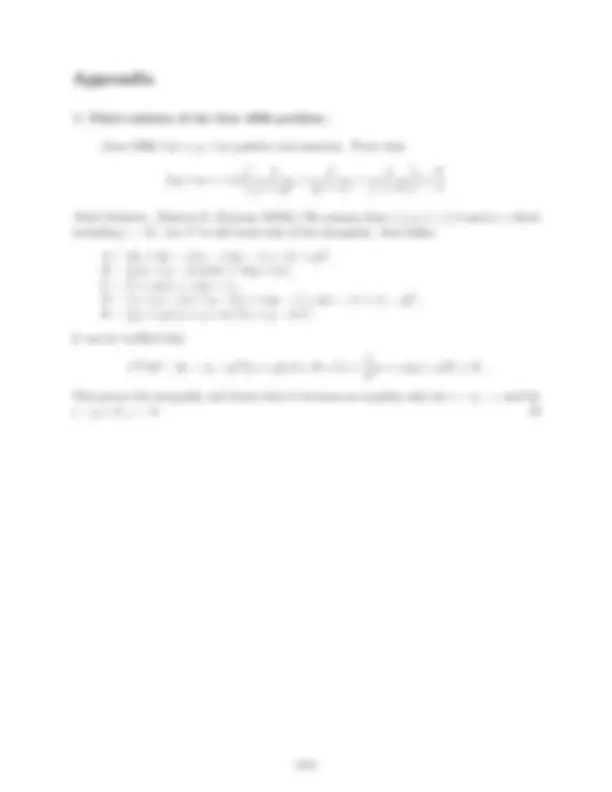
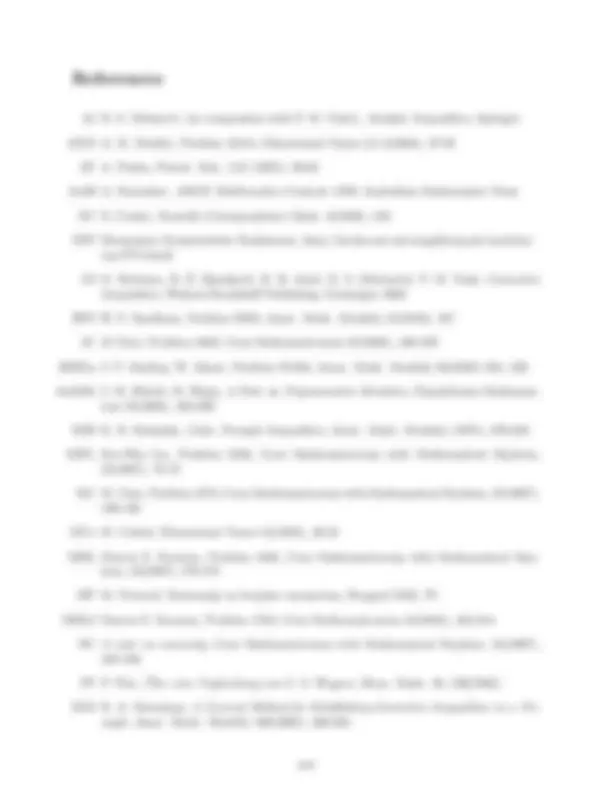



Estude fácil! Tem muito documento disponível na Docsity

Ganhe pontos ajudando outros esrudantes ou compre um plano Premium


Prepare-se para as provas
Estude fácil! Tem muito documento disponível na Docsity
Prepare-se para as provas com trabalhos de outros alunos como você, aqui na Docsity
Os melhores documentos à venda: Trabalhos de alunos formados
Prepare-se com as videoaulas e exercícios resolvidos criados a partir da grade da sua Universidade
Responda perguntas de provas passadas e avalie sua preparação.

Ganhe pontos para baixar
Ganhe pontos ajudando outros esrudantes ou compre um plano Premium
Comunidade
Peça ajuda à comunidade e tire suas dúvidas relacionadas ao estudo
Descubra as melhores universidades em seu país de acordo com os usuários da Docsity
Guias grátis
Baixe gratuitamente nossos guias de estudo, métodos para diminuir a ansiedade, dicas de TCC preparadas pelos professores da Docsity
Resolução de problemas de desigualdades
Tipologia: Notas de estudo
1 / 31

Esta página não é visível na pré-visualização
Não perca as partes importantes!
























Version 0.3 [2004/03/07]
Inequalities are useful in all fields of Mathematics. The purpose of this book is to present standard techniques in the theory of inequalities. In fact, this book is an extended and improved version of the author’s short article Note on Muirhead’s Theorem. Many of the problems are mathematical olympiads problems. I have given sources of the prob- lems at the end of the book. The book is available at
http://my.netian.com/∼ideahitme/eng.html
This is an unfinished manuscript. I would greatly appreciate hearing about any errors in the book, even minor ones. You can send all comments to the author at hojoolee@korea.com.
Tentative Plan
04/08/20 - 04/08/30 : Ver 0.5 - Chapter 4 and Chapter 5 04/12/20 - 04/12/30 : Ver 0.7 - Chapter 6 and Chapter 7
i
1 Substitutions iii
2 Homogenizations xiii
3 Normalizations xxiii
ii
It’s natural to ask that the inequality in the theorem 2 holds for arbitrary positive reals a, b, c? Yes! It’s possible to prove the inequality without the additional condition that a, b, c are the lengths of a triangle :
Theorem 3. Let x, y, z > 0. Then, we have xyz ≥ (y + z − x)(z + x − y)(x + y − z). The equality holds if and only if x = y = z.
Proof. Since the inequality is symmetric in the variables, without loss of generality, we may assume that x ≥ y ≥ z. Then, we have x + y > z and z + x > y. If y + z > x, then x, y, z are the lengths of the sides of a triangle. And by the theorem 2, we get the result. Now, we may assume that y + z ≤ x. However, in this case, we have xyz > 0 ≥ (y + z − x)(z + x − y)(x + y − z).
Not suprisingly, the inequality in the theorem 2 holds when some of x, y, z are zeros :
Theorem 4. Let x, y, z ≥ 0. Then, we have xyz ≥ (y + z − x)(z + x − y)(x + y − z).
Proof. Since x, y, z ≥ 0, we can find positive sequences {xn}, {yn}, {zn} for which
lim n→∞ xn = x, lim n→∞ yn = y, lim n→∞ zn = z.
(For example, take xn = x + (^) n^1 (n = 1, 2 , · · · ), etc.) Applying the theorem 2 yields
xnynzn ≥ (yn + zn − xn)(zn + xn − yn)(xn + yn − zn)
Now, taking the limits to both sides, we get the result.
Clearly, the equality holds when x = y = z. However, xyz = (y +z −x)(z +x−y)(x+y −z) and x, y, z ≥ 0 does not guarantee that x = y = z. In fact, for x, y, z ≥ 0, the equality xyz = (y + z − x)(z + x − y)(x + y − z) is equivalent to
x = y = z or x = y, z = 0 or y = z, x = 0 or z = x, y = 0.
It’s straightforward to verify the equality
xyz − (y + z − x)(z + x − y)(x + y − z) = x(x − y)(x − z) + y(y − z)(y − x) + z(z − x)(z − y).
Hence, the theorem 4 is a particular case of Schur’s inequality.^3 As a corollary, we have
Problem 1. (IMO 2000/2) Let a, b, c be positive numbers such that abc = 1. Prove that ( a − 1 +
b
b − 1 +
c
c − 1 +
a
Solution. Since abc = 1, we can make the substitution a = xy , b = yz , c = zx for x, y, z > 0.^4 We rewrite the given inequality in the terms of x, y, z : ( x y
z y
y z
x z
) ( (^) z
x
y x
≤ 1 ⇔ (y + z − x)(z + x − y)(x + y − z) ≥ xyz.
(^3) See the theorem 6 in the chpater 2. Take r = 1. (^4) For example, take x = 1, y = 1 a ,^ z^ =^ 1 ab.
iv
The Ravi Substitution is so useful when dealing with an inequality for the lengths a, b, c of a triangle. After the Ravi Substitution, we can remove the condition that they are the lengths of the sides of a triangle. Here are some examples :
Problem 2. (IMO 1983/6) Let a, b, c be the lengths of the sides of a triangle. Prove that
a^2 b(a − b) + b^2 c(b − c) + c^2 a(c − a) ≥ 0.
Solution. After the substitution a = y + z, b = z + x, c = x + y for x, y, z > 0, it becomes
x^3 z + y^3 x + z^3 y ≥ x^2 yz + xy^2 z + xyz^2 or
x^3 y
y^3 z
z^3 x
≥ x + y + z.
However, the Cauchy-schwarz inequality provides that
(y + z + x)
x^3 y
y^3 z
z^3 x
≥ (x + y + z)^2.
Problem 3. (IMO 1961/2) Show that, for any triangle with sides a, b, c and area S,
a^2 + b^2 + c^2 ≥ 4
Solution. Let s be the semiperimeter. It’s equivalent to (a^2 +b^2 +c^2 )^2 ≥ 48 s(s−a)(s−b)(s−c). Let a = y + z, b = z + x, c = x + y for x, y, z > 0. Then, it becomes ((y + z)^2 + (z + x)^2 + (x + y)^2 )^2 ≥ 48(x + y + z)xyz. However, we have
((y + z)^2 + (z + x)^2 + (x + y)^2 )^2 ≥ 16(yz + zx + xy)^2 ≥ 16 · 3(xy · yz + yz · zx + xy · yz).
Here, we used the well-known inequalities p^2 +q^2 ≥ 2 pq and (p+q +r)^2 ≥ 3(pq +qr +rp).
This is called the Weitzenb¨ock’s inequality. And there is a stronger generalization :
Exercise 2. (Hadwiger-Finsler Inequality) Show that, for any triangle with sides a, b, c and area S, 2 ab + 2bc + 2ca − (a^2 + b^2 + c^2 ) ≥ 4
Here is a two triangles generalization of the Weitzenb¨ock’s Inequality :
Exercise 3. (Pedoe’s Inequality) Let a 1 , b 1 , c 1 denote the sides of the triangle A 1 B 1 C 1 with area F 1. Let a 2 , b 2 , c 2 denote the sides of the triangle A 2 B 2 C 2 with area F 2. Show that
a 12 (a 22 + b 22 − c 22 ) + b 12 (b 22 + c 22 − a 22 ) + c 12 (c 22 + a 22 − b 22 ) ≥ 16 F 1 F 2.
If you are faced with an integral that contains square root expressions such as ∫ (^) √ 1 − x^2 dx,
1 + y^2 dy,
z^2 − 1 dz
then trigonometric substitutions such as x = sin t, y = tan t, z = sec t are very useful. When dealing with square root expressions, making a suitable trigonometric substitution simplifies the given inequality :
v
In any traingle ABC, is there a natural relation between cos A + cos B + cos C and Rr , where R and r are the radii of the circumcircle and incircle of ABC?
What is the most natural way to find some relations between X = Rr and Y = cos A + cos B + cos C? We already have nice identities :
2 abc (b + c − a)(c + a − b)(a + b − c)
b^2 + c^2 − a^2 2 bc
c^2 + a^2 − b^2 2 ca
a^2 + b^2 − c^2 2 ab
Hence, we wish to find a nice function F : Whenever a, b, c are the lengths of the sides of a triangle, we have F (X, Y ) = 0 ⇔
2 abc (b + c − a)(c + a − b)(a + b − c)
b^2 + c^2 − a^2 2 bc
c^2 + a^2 − b^2 2 ca
a^2 + b^2 − c^2 2 ab
We want to find a nice function f such that f (a, b, c) = 0, where f (a, b, c) = F (X, Y ). Now, one may easily check that t − 1, t, t + 1 are the lengths of the sides of a triangle for all t > 2. Hence, taking (a, b, c) = (t − 1 , t, t + 1) yields
f (t − 1 , t, t + 1) = F
2(t − 1)t(t + 1) (t + 2)t(t − 2)
t^2 + 4t 2 t(t + 1)
t^2 + 2 2(t + 1)(t − 1)
t^2 − 4 t 2(t − 1)t
which can be simplified as
F
2 t^2 − 2 t^2 − 4
3 t^2 − 6 2(t^2 − 1)
Letting X = 2 t (^2) − 2 t^2 − 4 , we get^ t
X− 2 or^ Y^ =^
(^2) (^4 XX−− 22 − (^1) ) or^ Y^ = 1 +^
1 X. It follows that
cos A + cos B + cos C = Y = 1 +
r R
where (a, b, c) = (t − 1 , t, t + 1) with t > 2. Futhermore, one may also easily check that cos A + cos B + cos C = 1 + (^) Rr holds for all right triangles. 6 Hence, it is natural to ask that
Does the identity cos A + cos B + cos C = 1 + (^) Rr hold for all triangles? Yes, and there is a simple way to verify this :
Theorem 7. Let R and r denote the radii of the circumcircle and incircle of the triangle ABC. Then, we have cos A + cos B + cos C = 1 + (^) Rr.
Proof. It follows from the identity a(b^2 + c^2 − a^2 ) + b(c^2 + a^2 − b^2 ) + c(a^2 + b^2 − c^2 ) = 2 abc + (b + c − a)(c + a − b)(a + b − c) that Y = 1 + (b+c−a)(c+ 2 abca−b )(a+b−c)= 1 + (^) X^1.
Although there is a two-line proof of the identity cos A + cos B + cos C = 1 + (^) Rr , I showed some ugly computations. The main reason is to present some motivations how to discover the relation. The identity is NOT TRIVIAL. Students should know that it’s not easy to discover some (new) results. Whenever you encounter some new results, you should think how to discover them. And whenever you meet tricky solutions of some non-trivial problems, you should try to find natural proofs.
(^6) Suppose that A = π 2 ,^ BC^ =^ a,^ CA^ =^ b,^ AB^ =^ c. Then, we have^ R^ =^ c^ and^ r^ =^ b+c−a
vii
Exercise 4. Let R and r be the radii of the circumcircle and incircle of the triangle ABC with BC = a, CA = b, AB = c. Let s denote the semiperimeter of ABC. Verify the follwing identities 7 :
(1) ab + bc + ca = s^2 + 4Rr + r^2 , (2) abc = 4Rrs, (3) cos A cos B + cos B cos C + cos C cos A = s (^2) − 4 R (^2) +r 2 4 R^2 , (4) cos A cos B cos C = s
(^2) −(2R+r) 2 4 R^2 Using the theorem 7, we can present an alternative proof of the theorem 1 : To show R ≥ 2 r, we need to prove that 1 + (^) Rr ≤ 32 or cos A + cos B + cos C ≤ 32. Thus, we give another proof of the theorem 5.
Third Proof. We make the substitution p = cos A, q = cos B, r = cos C. Then, p, q, r ∈ (0, 1). We want to show that p + q + r ≤ 32. It follows from π − C = A + B that r = − cos(A+B) = −pq+sin A sin B or (r+pq)^2 = sin^2 A sin^2 B or (r+pq)^2 = (1−p^2 )(1−q^2 ),
which becomes 1 = p^2 + q^2 + r^2 + 2pqr. It follows that 1 − r^2 ≤
(p+q 2
(p+q 2
r so that
p + q ≤
2(1 − r). Thus, it suffices to show that
2(1 − r) + r ≤ 32. After the substitution
t =
2(1 − r) (0 < t <
2), we get r = −t 2 2 + 1 and it becomes^ t^ −^
t^2 2 + 1^ ≤^
3 2 , which is equivalent to −^12 (t − 1)^2 ≤ 0.
In the above proof, we see that p = cos A, q = cos B, r = cos C satisfies the equation p^2 + q^2 + r^2 + 2pqr = 1. It follows that cos^2 A + cos^2 B + cos^2 C + 2 cos A cos B cos C = 1.^8 The converse is also true :
Exercise 5. (a) Let p, q, r be the positive real numbers such that p^2 + q^2 + r^2 + 2pqr = 1. Show that there exist an acute triangle ABC such that p = cos A, q = cos B, r = cos C. (b) Let p, q, r ≥ 0 with p^2 + q^2 + r^2 + 2pqr = 1. Show that there are A, B, C ∈
0 , π 2
with p = cos A, q = cos B, r = cos C, and A + B + C = π.
Problem 5. (USA 2001/3) Let a, b, and c be nonnegative real numbers such that a^2 + b^2 + c^2 + abc = 4. Prove that 0 ≤ ab + bc + ca − abc ≤ 2.
Solution. Notice that a, b, c > 1 implies that a^2 + b^2 + c^2 + abc > 4. If a ≤ 1, then we have ab + bc + ca − abc ≥ (1 − a)bc ≥ 0. We now prove that ab + bc + ca − abc ≤ 2. Letting a = 2p, b = 2q, c = 2r, we get p^2 + q^2 + r^2 + 2pqr = 1. Hence, by the previous exercise, we can write a = 2 cos A, b = 2 cos B, c = 2 cos C for some A, B, C ∈
0 , π 2
with A + B + C = π. And we are required to prove
cos A cos B + cos B cos C + cos C cos A − 2 cos A cos B cos C ≤
One may assume that A ≥ π 3 or 1 − 2 cos A ≥ 0. Now, notice that cos A cos B + cos B cos C + cos C cos A − 2 cos A cos B cos C = cos A(cos B + cos C) + cos B cos C(1 − 2 cos A). We apply
(^7) For more identities, see the exercise 10. (^8) Let’s examine the case (A, B, C) = ( π 2 , θ,^ π 2 −^ θ). The cosine identity gives us cos (^2) θ + sin (^2) θ = 1. So, it’s
a three variables generalization of the well-known identity cos^2 θ + sin^2 θ = 1!
viii
Problem 7. (IMO 1995/2) Let a, b, c be positive numbers such that abc = 1. Prove that
1 a^3 (b + c)
b^3 (c + a)
c^3 (a + b)
Solution. After the substitution a = (^) x^1 , b = (^1) y , c = (^1) z , we get xyz = 1. And the inequality takes the form x^2 y + z
y^2 z + x
z^2 x + y
It follows from the Cauchy-schwarz inequality that
[(y + z) + (z + x) + (x + y)]
x^2 y + z
y^2 z + x
z^2 x + y
≥ (x + y + z)^2
so that, by the AM-GM inequality,
x^2 y + z
y^2 z + x
z^2 x + y
x + y + z 2
3(xyz) (^13)
2
Let’s conlculde by giving another solution of the problem 4 :
Second Solution. Set a = (^) x^1 , b = (^1) y , c = (^1) z. Then, we find that a + b + c = abc is equivalent to 1 = xy + yz + zx. The inequality becomes
x √ x^2 + 1
y √ y^2 + 1
z √ z^2 + 1
or x √ x^2 + xy + yz + zx
y √ y^2 + xy + yz + zx
z √ z^2 + xy + yz + zx
or x √ (x + y)(x + z)
y √ (y + z)(y + x)
z √ (z + x)(z + y)
By the AM-GM inequality, we have
x √ (x + y)(x + z)
x
(x + y)(x + z) (x + y)(x + z)
x[(x + y) + (x + z)] (x + y)(x + z)
x x + z
x x + z
In a like manner, we obtain
y √ (y + z)(y + x)
y y + z
y y + x
and
z √ (z + x)(z + y)
z z + x
z z + y
Adding these three yields the required result.
x
Exercise 7. Let f (x, y) be a real polynomial such that, for all θ ∈ R^3 ,
f (cos θ, sin θ) = 0.
Show that the polynomial f (x, y) is divisible by x^2 + y^2 − 1.
Exercise 8. Let f (x, y, z) be a real polynomial. Suppose that
f (cos α, cos β, cos γ) = 0,
for all α, β, γ ∈ R^3 with α + β + γ = π. Show that the polynomial f (x, y, z) is divisible by x^2 + y^2 + z^2 + 2xyz − 1. 10
Exercise 9. (IMO Unused 1986) Let a, b, c be positive real numbers. Show that
(a + b − c)^2 (a − b + c)^2 (−a + b + c)^2 ≥ (a^2 + b^2 − c^2 )(a^2 − b^2 + c^2 )(−a^2 + b^2 + c^2 ). 11
Exercise 10. With the usual notation for a triangle, verify the follwing identities :
(1) sin A + sin B + sin C = (^) Rs (2) sin A sin B + sin B sin C + sin C sin A = s (^2) +4Rr+r 2 4 R^2 (3) sin A sin B sin C = 2 srR 2 (4) sin^3 A + sin^3 B + sin^3 C = s(s
(^2) − 6 Rr− 3 r (^2) ) 4 R^3 (5) cos^3 A + cos^3 B + cos^3 C = (2R+r)
(^3) − 3 rs (^2) − 4 R 3 4 R^3 (6) tan A + tan B + tan C = tan A tan B tan C = (^) s (^2) −(2^2 rsR+r) 2 (7) tan A tan B + tan B tan C + tan C tan A = s (^2) − 4 Rr−r 2 s^2 −(2R+r)^2 (8) cot A + cot B + cot C = s
(^2) − 4 Rr−r 2 2 sr (9) sin A 2 sin B 2 sin C 2 = 4 rR (10) cos A 2 cos B 2 cos C 2 = 4 sR
Exercise 11. Let a, b, c be the lengths of the sides of a triangle. And let s be the semiperime- ter of the triangle. Then, the following inequalities holds.
(a) 3(ab + bc + ca) ≤ (a + b + c)^2 < 4(ab + bc + ca) (b) [JfdWm] a^2 + b^2 + c^2 ≥ (^3635)
s^2 + abcs
(c) [AP] 8(s − a)(s − b)(s − c) ≤ abc (d) [EC] 8 abc ≥ (a + b)(b + c)(c + a) (e) [AP] 3(a + b)(b + c)(c + a) ≤ 8(a^3 + b^3 + c^3 ) (f ) [MC] 2(a + b + c)(a^2 + b^2 + c^2 ) ≥ 3(a^3 + b^3 + c^3 + 3abc) (g) abc < a^2 (s − a) + b^2 (s − b) + c^2 (s − c) ≤ 32 abc (h) bc(b + c) + ca(c + a) + ab(a + b) ≥ 48(s − a)(s − b)(s − c) (i) (^) s−^1 a + (^) s−^1 b + (^) s−^1 c ≥ (^9) s (^10) For a proof, see [JmhMh]. (^11) If we assume that there is a triangle ABC with BC = a, CA = b, AB = c, then it’s equivalent to the
inequality s^2 ≤ 4 R^2 + 4Rr + 3r^2 in the exercise 6.
xi
Some inequality problems come with constraints such as ab = 1, xyz = 1, x + y + z = 1. Non-homogeneous symmetric inequalities can be transformed into a homogeneous one. Then we apply two powerful theorems : Shur’s Inequality and Muirhead’s Theorem. We begin with the following example.
Problem 8. (Hungary 1996) Let a and b be positive real numbers with a + b = 1. Prove that 13 ≤ a
2 a+1 +^
b^2 b+.
Solution. Using the condition a + b = 1, we can reduce the given inequality to homogeneous one, i. e. 13 ≤ a
2 (a+b)(a+(a+b)) +^
b^2 (a+b)(b+(a+b)) or (a+b)(2a+b)(2b+a)^ ≤^ 3(a
(^2) (a+2b)+b (^2) (2a+b))
which becomes 2(a^3 + b^3 ) + 7(a^2 b + ab^2 ) ≤ 3(a^3 + b^3 ) + 6(a^2 b + ab^2 ) which implies a^2 b + ab^2 ≤ a^3 + b^3 which follows from (a^3 + b^3 ) − (a^2 b + ab^2 ) = (a − b)^2 (a + b) ≥ 0. The equality holds if and only if a = b = 12.
The above inequality a^2 b + ab^2 ≤ a^3 + b^3 can be generalized as following :
Theorem 8. Let a 1 , a 2 , b 1 , b 2 be positive real numbers such that a 1 + a 2 = b 1 + b 2 and max(a 1 , a 2 ) ≥ max(b 1 , b 2 ). And let x and y be nonnegative real numbers. Then, we have xa^1 ya^2 + xa^2 ya^1 ≥ xb^1 yb^2 + xb^2 yb^1.
Proof. Without loss of generality, we can assume that a 1 ≥ a 2 , b 1 ≥ b 2 , a 1 ≥ b 1. If x or y is zero, then it clearly holds. So, we also assume that both x and y are nonzero. It is easy to check the following :
xa^1 ya^2 + xa^2 ya^1 − xb^1 yb^2 − xb^2 yb^1 = xa^2 ya^2
xa^1 −a^2 + ya^1 −a^2 − xb^1 −a^2 yb^2 −a^2 − xb^2 −a^2 yb^1 −a^2
= xa^2 ya^2
xb^1 −a^2 − yb^1 −a^2
xb^2 −a^2 − yb^2 −a^2
xa^2 ya^2
xb^1 − yb^1
xb^2 − yb^2
Remark 1. When does the equality hold in the theorem 8?
xiii
Before giving an example for the case of three variables inequality, we introduce two summation notations
cyclic and^
sym. Let^ P^ (x, y, z) be a three variables function of^ x,^ y, z. Let us define : ∑
cyclic
P (x, y, z) = P (x, y, z) + P (y, z, x) + P (z, x, y),
sym
P (x, y, z) = P (x, y, z) + P (x, z, y) + P (y, x, z) + P (y, z, x) + P (z, x, y) + P (z, y, x)
For example, we know that ∑
cyclic
x^3 y = x^3 y + y^3 z + z^3 x,
sym
x^3 = 2(x^3 + y^3 + z^3 )
sym
x^2 y = x^2 y + x^2 z + y^2 z + y^2 x + z^2 x + z^2 y,
sym
xyz = 6xyz.
Problem 9. (IMO 1984/1) Let x, y, z be nonnegtive real numbers such that x + y + z = 1. Prove that 0 ≤ xy + yz + zx − 2 xyz ≤ 277.
Solution. Using the condition x + y + z = 1, we can reduce the given inequality to homoge- neous one, i. e. 0 ≤ (xy + yz + zx)(x + y + z) − 2 xyz ≤ 277 (x + y + z)^3. The left hand side inequality is trivial because it’s equivalent to 0 ≤ xyz +
sym x
(^2) y and x, y, z ≥ 0. The right
hand side inequality simplifies to 7
cyclic x (^3) + 15xyz − 6 ∑ sym x (^2) y ≥ 0. Since 7 ∑ cyclic x
15 xyz − 6
sym x
(^2) y = 2 ∑ cyclic x
sym x
(^2) y + 5
3 xyz +
cyclic x
sym x
(^2) y
it will be
enough to show that 2
cyclic x
sym x (^2) y and 3xyz +∑ cyclic x
sym x (^2) y. We note that
2
cyclic x
sym x
(^2) y = ∑ cyclic(x
(^3) +y (^3) )−∑ cyclic(x
(^2) y+xy (^2) ) = ∑ cyclic(x
(^3) +y (^3) −x (^2) y−xy (^2) ) ≥ 0.
The second inequality can be written as
cyclic x(x^ −^ y)(x^ −^ z)^ ≥^ 0 , which is a particular case of the following Schur’s inequality :
Theorem 9. (Schur) Let x, y, z be nonnegative real numbers. Then for any r > 0 , we have
∑
cyclic
xr(x − y)(x − z) ≥ 0.
Proof. Since the inequality is symmetric in the three variables, we may assume without loss of generality that x ≥ y ≥ z. Then the given inequality may be rewritten as
(x − y)[xr(x − z) − yr(y − z)] + zr(x − z)(y − z) ≥ 0 ,
and every term on the left-hand side is clearly nonnegative.
Remark 2. When does the equality hold in Theorem 9?
The following special case of Schur’s inequality is useful : ∑
cyclic
x(x − y)(x − z) ≥ 0 ⇔ 3 xyz +
cyclic
x^3 ≥
sym
x^2 y.
Here is another solution of the problem 1 :
xiv
Theorem 10. (Muirhead) Let a 1 , a 2 , a 3 , b 1 , b 2 , b 3 be real numbers such that
a 1 ≥ a 2 ≥ a 3 ≥ 0 , b 1 ≥ b 2 ≥ b 3 ≥ 0 , a 1 ≥ b 1 , a 1 + a 2 ≥ b 1 + b 2 , a 1 + a 2 + a 3 = b 1 + b 2 + b 3.^2
And let x, y, z be positive real numbers. Then, we have
sym x
a (^1) ya (^2) za (^3) ≥ ∑ sym x
b (^1) yb (^2) zb (^3).
Proof. Case 1. b 1 ≥ a 2 : It follows from a 1 ≥ a 1 + a 2 − b 1 and from a 1 ≥ b 1 that a 1 ≥ max(a 1 +a 2 −b 1 , b 1 ) so that max(a 1 , a 2 ) = a 1 ≥ max(a 1 +a 2 −b 1 , b 1 ). From a 1 +a 2 −b 1 ≥ b 1 + a 3 − b 1 = a 3 and a 1 + a 2 − b 1 ≥ b 2 ≥ b 3 , we have max(a 1 + a 2 − b 1 , a 3 ) ≥ max(b 2 , b 3 ). Then, applying the theorem 1 twice, we have that
sym x
a (^1) ya (^2) za (^3) = ∑ cyclic z
a (^3) (xa (^1) ya (^2) +
xa^2 ya^1 ) ≥
cyclic z
a (^3) (xa 1 +a 2 −b (^1) yb (^1) + xb (^1) ya 1 +a 2 −b (^1) ) = ∑ cyclic x
b (^1) (ya 1 +a 2 −b (^1) za (^3) + ya (^3) za 1 +a 2 −b (^1) ) ≥ ∑ cyclic x
b (^1) (yb (^2) zb (^3) + yb (^3) zb (^2) ) = ∑ sym x
b (^1) yb (^2) zb (^3).
Case 2. b 1 ≤ a 2 : It follows from 3b 1 ≥ b 1 +b 2 +b 3 = a 1 +a 2 +a 3 ≥ b 1 +a 2 +a 3 that b 1 ≥ a 2 + a 3 − b 1 and that a 1 ≥ a 2 ≥ b 1 ≥ a 2 + a 3 − b 1. Therefore, we have max(a 2 , a 3 ) ≥ max(b 1 , a 2 + a 3 −b 1 ) and max(a 1 , a 2 +a 3 −b 1 ) ≥ max(b 2 , b 3 ). Then, applying the theorem 1 twice, we have that
sym x
a (^1) ya (^2) za (^3) = ∑ cyclic x
a (^1) (ya (^2) za (^3) +ya (^3) za (^2) ) ≥ ∑ cyclic x
a (^1) (yb (^1) za 2 +a 3 −b (^1) +ya 2 +a 3 −b (^1) zb (^1) ) = ∑ cyclic y
b (^1) (xa (^1) za 2 +a 3 −b (^1) + xa 2 +a 3 −b (^1) za (^1) ) ≥ ∑ cyclic y
b (^1) (xb (^2) zb (^3) + xb (^3) zb (^2) ) = ∑ sym x
b (^1) yb (^2) zb (^3).
Remark 3. The equality holds if and only if x = y = z. However, if we allow x = 0 or y = 0 or z = 0, 3 then one may easily check that the equality holds if and only if
x = y = z or x = y, z = 0 or y = z, x = 0 or z = x, y = 0.
The following problem can be solved by applying Muirhead’s theorem :
Problem 11. (IMO 1995) Let a, b, c be positive numbers such that abc = 1. Prove that
1 a^3 (b + c)
b^3 (c + a)
c^3 (a + b)
Solution. It’s equivalent to
1 a^3 (b + c)
b^3 (c + a)
c^3 (a + b)
2(abc)^4 /^3
Set a = x^3 , b = y^3 , c = z^3 with x, y, z > 0. Then, it becomes
cyclic
1 x^9 (y^3 +z^3 ) ≥^
3 2 x^4 y^4 z^4. Clearing denominators, this becomes ∑
sym
x^12 y^12 + 2
sym
x^12 y^9 z^3 +
sym
x^9 y^9 z^6 ≥ 3
sym
x^11 y^8 z^5 + 6x^8 y^8 z^8
or ( ∑
sym
x^12 y^12 −
sym
x^11 y^8 z^5
sym
x^12 y^9 z^3 −
sym
x^11 y^8 z^5
sym
x^9 y^9 z^6 −
sym
x^8 y^8 z^8
and every term on the left hand side is nonnegative by the theorem 3.
(^2) Note the equality in the final equation. (^3) However, in this case, we assume that 0 (^0) = 1 in the sense that limx→ 0 + x (^0) = 1. In general, 0 (^0) is not
defined. Note also that limx→ 0 + 0 x^ = 0.
xvi
Problem 12. (Iran 1996) Let x, y, z be positive real numbers. Prove that
(xy + yz + zx)
(x + y)^2
(y + z)^2
(z + x)^2
Solution. It’s equivalent to
4
sym
x^5 y + 2
cyclic
x^4 yz + 6x^2 y^2 z^2 −
sym
x^4 y^2 − 6
cyclic
x^3 y^3 − 2
sym
x^3 y^2 z ≥ 0
or ( ∑
sym
x^5 y −
sym
x^4 y^2
sym
x^5 y −
sym
x^3 y^3
cyclic
x(x − y)(x − z)
By Muirhead’s theorem and Schur’s ineuquality, we find that it’s a sum of three terms which are nonnegative.
There is an alternative way^4 to attack the above problem without Muirhead’s theorem and Schur’s ineuquality. We need to prove the following lemma.
Lemma 1. Let x, y, z be positive numbers. Set p = x + y + z, q = xy + yz + zx, and r = xyz. Then, we have (1) p^3 − 4 pq + 9r ≥ 0 , (2) p^4 − 5 p^2 q + 4q^2 + 6pr ≥ 0 , (3) pq − 9 r ≥ 0.^5
Proof. They are equivalent to
(1′) x(x − y)(x − z) + y(y − z)(y − x) + z(z − x)(z − y) ≥ 0 , (2′) x^2 (x − y)(x − z) + y^2 (y − z)(y − x) + z^2 (z − x)(z − y) ≥ 0 , (3′) x(y − z)^2 + y(z − x)^2 + z(x − y)^2 ≥ 0.
We leave the details for the readers.
Second Solution. We make the substitution p = x + y + z, q = xy + yz + zx, r = xyz. Notice that (x + y)(y + z)(z + x) = (x + y + z)(xy + yz + zx) − xyz = pq − r. One may easily rewrite the given inequality in the terms of p, q, r :
q
(p^2 + q)^2 − 4 p(pq − r) (pq − r)^2
or 4 p^4 q − 17 p^2 q^2 + 4q^3 + 34pqr − 9 r^2 ≥ 0
or pq(p^3 − 4 pq + 9r) + q(p^4 − 5 p^2 q + 4q^2 + 6pr) + r(pq − 9 r) ≥ 0.
We find that every term on the left hand side is nonnegative by the lemma.
(^4) See also the appendix [1]. (^5) When does equality hold in each inequality? For more p-q-r inequalities, see the exercise 21 and visit
the site [ESF].
xvii
Thus, it will be suffice to show that
∑
cyclic
2(a + b + c)(b + c − a) 4 a^2 + b^2 + c^2
After expanding the above inequality, we see that it becomes
2
cyclic
a^6 + 4
cyclic
a^4 bc + 20
sym
a^3 b^2 c + 68
cyclic
a^3 b^3 + 16
cyclic
a^5 b ≥ 276 a^2 b^2 c^2 + 27
cyclic
a^4 b^2.
We note that this cannot be proven by just applying Muirhead’s Theorem. Since a, b, c are the sides of a triangle, we can make the Ravi Substitution a = y + z, b = z + x, c = x + y, where x, y, z > 0. After some brute-force algebra, we can rewrite the above inequality as
25
sym
x^6 + 230
sym
x^5 y + 115
sym
x^4 y^2 + 10
sym
x^3 y^3 + 80
sym
x^4 yz
sym
x^3 y^2 z + 124
sym
x^2 y^2 z^2.
Now, by Muirhead’s theorem, we get the result!
We notice that there are homogeneous symmetric polynomial inequalities which cannot be solved by just applying Muirhead’s theorem. See the following inequality :
5
cyclic
x^6 + 15
sym
x^4 y^2 + 2
sym
x^3 y^2 z + 3x^2 y^2 z^2 ≥ 8
sym
x^5 y + 8
cyclic
x^4 yz + 16
cyclic
x^3 y^3
This holds for all positive real numbers x, y, and z. However, it is not a direct consequence of Muirhead’s theorem because the coefficents of
sym x
(^5) y and ∑ cyclic x
(^3) y (^3) are too big. In
fact, it is equivalent to
1 6
cyclic
(y − z)^4 (x^2 + 15y^2 + 15z^2 + 8xy + 4yz + 8zx) ≥ 0.^7
As I know, there is no general criterion to attack the symmetric polynomial inequalities. However, the author found a result for the homogeneous symmetric polynomial inequalities with degree 3. It’s a direct consequence of Muirhead’s theorem and Schur’s inequality.
Theorem 11. Let P (u, v, w) ∈ R[u, v, w] be a homogeneous symmetric polynomial with degree 3. Then the following two statements are equivalent.
(a) P (1, 1 , 1), P (1, 1 , 0), P (1, 0 , 0) ≥ 0. (b) P (x, y, z) ≥ 0 for all x, y, z ≥ 0.
Proof. It will be suffice to prove that (a) implies (b). Let
P (u, v, w) = A
cyclic
u^3 + B
sym
u^2 v + Cuvw.
(^7) These inequality and identity are in [JC].
xix
Let p = P (1, 1 , 1) = 3A + 6B + C, q = P (1, 1 , 0) = A + B, and r = P (1, 0 , 0) = A. We have A = r, B = q − r, C = p − 6 q + 3r, and p, q, r ≥ 0. Let x, y, z ≥ 0. It follows that
P (x, y, z) = r
cyclic
x^3 + (q − r)
sym
x^2 y + (p − 6 q + 3r)xyz.
Case 1. q ≥ r : We find that
P (x, y, z) =
r 2
sym
x^3 −
sym
xyz
sym
x^2 y −
sym
xyz
and that the every term on the right hand side is nonnegative.
Case 2. q ≤ r : We find that
P (x, y, z) =
q 2
sym
x^3 −
sym
xyz
cyclic
x^3 + 3xyz −
sym
x^2 y
and that the every term on the right hand side is nonnegative.
For example, we can apply the theorem 11 to solve the problem 9.
(IMO 1984/1) Let x, y, z be nonnegtive real numbers such that x + y + z = 1. Prove that 0 ≤ xy + yz + zx − 2 xyz ≤ 277.
Solution. Using x + y + z = 1, we homogenize the given inequality as following :
0 ≤ (xy + yz + zx)(x + y + z) − 2 xyz ≤
(x + y + z)^3
Let us define L(u, v, w), R(u, v, w) ∈ R[u, v, w] by
L(u, v, w) = (uv + vw + wu)(u + v + w) − 2 uvw,
R(u, v, w) =
(u + v + w)^3 − (uv + vw + wu)(u + v + w) + 2uvw.
However, one may easily check that L(1, 1 , 1) = 7, L(1, 1 , 0) = 2, L(1, 0 , 0) = 0, R(1, 1 , 1) = 0, R(1, 1 , 0) = 272 , and R(1, 0 , 0) = 277.
Exercise 16. (M. S. Klamkin [MEK2]) Determine the maximum and minimum values of
x^2 + y^2 + z^2 + λxyz
where x + y + z = 1, x, y, z ≥ 0 , and λ is given constant.
Exercise 17. (Walter Janous [MC]) let x, y, z ≥ 0 with x+y +z = 1. For fixed real numbers a ≥ 0 and b, determine the maximum c = c(a, b) such that
a + bxyz ≥ c(xy + yz + zx).
xx